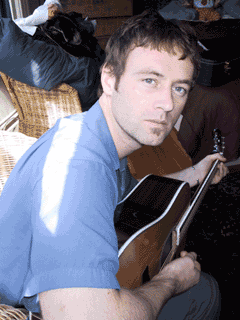I had meant to blog this triathlon training thing on a regular basis, however, as usual when taking on something new, I underestimated how time consuming and difficult this training would be. My guitars are gathering dust, so intensive have been the last few weeks. The kids do get dusted off occasionally, but even they are temporarily orphaned on this altar of athletic achievement. So here I am, half way into my nine week training program and nary a blog post published, at least none concerning progress of a sporting variety. So, this is how it has gone:
When I decided I was going to do this, there were two major obstacles: my torn meniscus (more later), and time. A wise man once told me that while it's possible to have lots time, and lots of money, having both simultaneously is a rare thing indeed.Although I have very little time, I am gainfully employed, so it seemed throwing som some money at it might enable me to maximise my time. With that in mind, I joined the Endurance Performance Centers, and I also arranged for a friend, experienced in such things, to draw me up a nine week training plan, scientifically designed to deposit me at the start of the Wildflower triathlon, in peak form. The fact that my friend had previously worked for Endurance was not a coincidence. They are an outfit specifically geared towards getting bikers in peak shape. To do this, I first had a fitness assessment. This meant wearing a gas exchange mask, and a heart rate monitor while riding a bike hooked up to a computer. I first rode until the test showed that although working hard, I had reached the limit of my bodies ability to absorb oxygen, i.e. my VO2 max. For the next test, I rode constantly while the watts I needed to put out increased every two minutes, until I could go no further. At 310 watts I topped out, my legs screaming at me to stop. Previous to all this, I stood on a super dooper high tech weighing scale that weighed me, calculated my body fat, and the individual muscle density of my legs and arms, and my basal metabolic rate. All this was used to calculate my VT1 and VT2. These are my training thresholds and each one is a combination of heart rate, wattage and VO2. Ideally you train within them, pushing above VT2 for short periods to increase your lactate thresholds. Then I got a review of this with an expert, explaining what it meant and how I could apply it, and how I should fuel as I trained. I came out as fit and healthy, although any dreams of a future stint in the Tour de France peloton were well and truly scuppered. With a V02 max of 47, I was in the high end of my age and of an average person, but well below that of a professional. For example Lance Armstrong's VO2 max is in the 80s. It seems I am in no way a superman, not that I needed a test to tell me that. The most important thing they measure is your efficiency, how well you use the energy you produce. Mostly this is all about pedaling technique. My score wasn’t great. However this is not a bad thing. You may be able to up your V02 max, but often its limit is genetically defined. Your power output may also increase but for some people it doesn’t improve much. Efficiency however, can always be improved. This explains why there are professional athletes with lower VO2 maxes who are incredibly efficient.
After all this, I started on a program of twice weekly 90 minute eCycling classes at Endurance. This is basically a class of bikers with their bikes mounted on a CompuTrainer (device for generating wattage load). Each person has four wattage zones. Z1 is easy, Z2 a little harder, Z3 is hard, and Z4 is only sustainable for a minute or so. The instructor brings the class through sets of intervals designed to help build endurance and simulate real world cycling, hills, descents, time trials, pace lines, and sprinting. All of this is done with a constant focus on efficient technique. “Keep it pretty!” our trainer shouts as we try to hold 25 miles an hour in Z4 for a minute. “Dance with a swan, don’t wrestle with a pig!” I finished many classes smelling of bacon. The classes do an eight week rotation, getting progressively harder, after which you get tested again. You should show substantial gains in every area. Although I haven’t retested yet, I am already working way above my initial numbers. Concurrent to this, my friend developed a training program that included twice weekly swims, starting at 2500 metres and working up to 3500 metres, and runs that incorporate some hill sprints to build strength. On the weekends I get to ride outside, usually a long ride three or four hours, but never too hard.
Over all I feel great, a little tired most evenings, and early to bed is the norm. However I’ve lost almost 10lbs, my max wattage on the bike has jumped dramatically, and my efficiency is hugely improved. When I ride with my friends that train all year round and race occasionally, I can now keep up. So, at the half way mark it’s all working as planned. My greatest worry was that my knee wouldn't hold up, but to my delight as my legs have gotten stronger my torn meniscus seems to have healed, and bar an occasional twinge, seems to be fine.
Labels: Endurance Performance Centers, Triathlons

